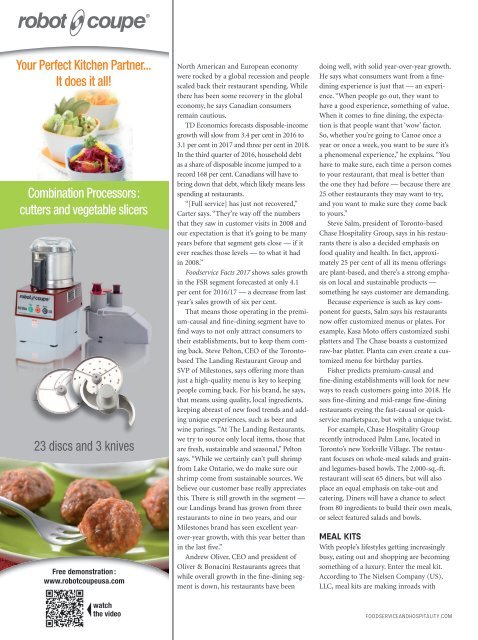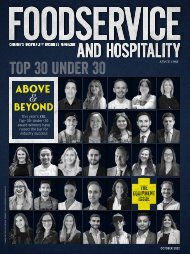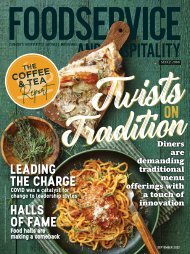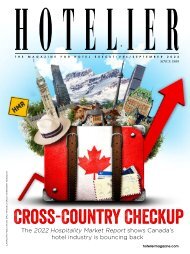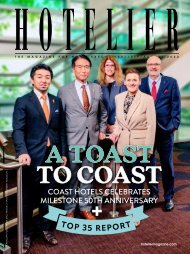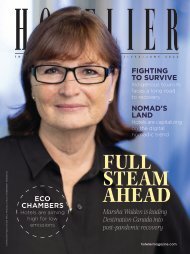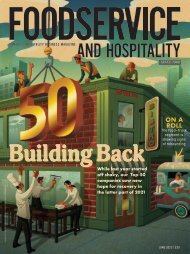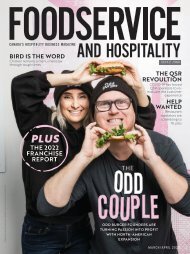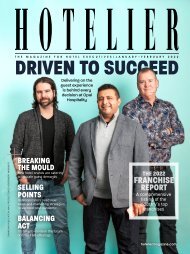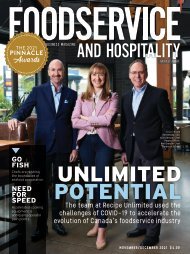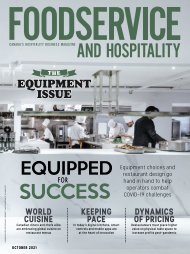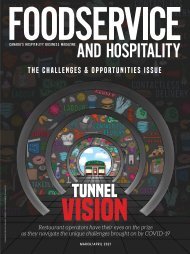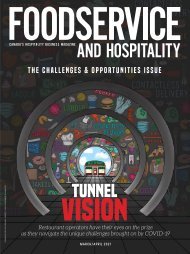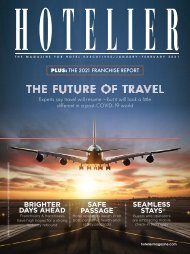FH1117
You also want an ePaper? Increase the reach of your titles
YUMPU automatically turns print PDFs into web optimized ePapers that Google loves.
Your Perfect Kitchen Partner...<br />
It does it all!<br />
Combination Processors :<br />
cutters and vegetable slicers<br />
23 discs and 3 knives<br />
Free demonstration :<br />
www.robotcoupeusa.com<br />
North American and European economy<br />
were rocked by a global recession and people<br />
scaled back their restaurant spending. While<br />
there has been some recovery in the global<br />
economy, he says Canadian consumers<br />
remain cautious.<br />
TD Economics forecasts disposable-income<br />
growth will slow from 3.4 per cent in 2016 to<br />
3.1 per cent in 2017 and three per cent in 2018.<br />
In the third quarter of 2016, household debt<br />
as a share of disposable income jumped to a<br />
record 168 per cent. Canadians will have to<br />
bring down that debt, which likely means less<br />
spending at restaurants.<br />
“[Full service] has just not recovered,”<br />
Carter says. “They’re way off the numbers<br />
that they saw in customer visits in 2008 and<br />
our expectation is that it’s going to be many<br />
years before that segment gets close — if it<br />
ever reaches those levels — to what it had<br />
in 2008.”<br />
Foodservice Facts 2017 shows sales growth<br />
in the FSR segment forecasted at only 4.1<br />
per cent for 2016/17 — a decrease from last<br />
year’s sales growth of six per cent.<br />
That means those operating in the premium-causal<br />
and fine-dining segment have to<br />
find ways to not only attract consumers to<br />
their establishments, but to keep them coming<br />
back. Steve Pelton, CEO of the Torontobased<br />
The Landing Restaurant Group and<br />
SVP of Milestones, says offering more than<br />
just a high-quality menu is key to keeping<br />
people coming back. For his brand, he says,<br />
that means using quality, local ingredients,<br />
keeping abreast of new food trends and adding<br />
unique experiences, such as beer and<br />
wine parings. “At The Landing Restaurants,<br />
we try to source only local items, those that<br />
are fresh, sustainable and seasonal,” Pelton<br />
says. “While we certainly can’t pull shrimp<br />
from Lake Ontario, we do make sure our<br />
shrimp come from sustainable sources. We<br />
believe our customer base really appreciates<br />
this. There is still growth in the segment —<br />
our Landings brand has grown from three<br />
restaurants to nine in two years, and our<br />
Milestones brand has seen excellent yearover-year<br />
growth, with this year better than<br />
in the last five.”<br />
Andrew Oliver, CEO and president of<br />
Oliver & Bonacini Restaurants agrees that<br />
while overall growth in the fine-dining segment<br />
is down, his restaurants have been<br />
doing well, with solid year-over-year growth.<br />
He says what consumers want from a finedining<br />
experience is just that — an experience.<br />
“When people go out, they want to<br />
have a good experience, something of value.<br />
When it comes to fine dining, the expectation<br />
is that people want that ‘wow’ factor.<br />
So, whether you’re going to Canoe once a<br />
year or once a week, you want to be sure it’s<br />
a phenomenal experience,” he explains. “You<br />
have to make sure, each time a person comes<br />
to your restaurant, that meal is better than<br />
the one they had before — because there are<br />
25 other restaurants they may want to try,<br />
and you want to make sure they come back<br />
to yours.”<br />
Steve Salm, president of Toronto-based<br />
Chase Hospitality Group, says in his restaurants<br />
there is also a decided emphasis on<br />
food quality and health. In fact, approximately<br />
25 per cent of all its menu offerings<br />
are plant-based, and there’s a strong emphasis<br />
on local and sustainable products —<br />
something he says customer are demanding.<br />
Because experience is such as key component<br />
for guests, Salm says his restaurants<br />
now offer customized menus or plates. For<br />
example, Kasa Moto offers customized sushi<br />
platters and The Chase boasts a customized<br />
raw-bar platter. Planta can even create a customized<br />
menu for birthday parties.<br />
Fisher predicts premium-causal and<br />
fine-dining establishments will look for new<br />
ways to reach customers going into 2018. He<br />
sees fine-dining and mid-range fine-dining<br />
restaurants eyeing the fast-causal or quickservice<br />
marketspace, but with a unique twist.<br />
For example, Chase Hospitality Group<br />
recently introduced Palm Lane, located in<br />
Toronto’s new Yorkville Village. The restaurant<br />
focuses on whole-meal salads and grainand<br />
legumes-based bowls. The 2,000-sq.-ft.<br />
restaurant will seat 65 diners, but will also<br />
place an equal emphasis on take-out and<br />
catering. Diners will have a chance to select<br />
from 80 ingredients to build their own meals,<br />
or select featured salads and bowls.<br />
MEAL KITS<br />
With people’s lifestyles getting increasingly<br />
busy, eating out and shopping are becoming<br />
something of a luxury. Enter the meal kit.<br />
According to The Nielsen Company (US),<br />
LLC, meal kits are making inroads with<br />
watch<br />
the video<br />
FOODSERVICEANDHOSPITALITY.COM


